Join us for a free guided tour of Bonington Gallery’s latest exhibition with BSL interpretation.
Book your free place and enjoy a tour of Bonington Gallery’s first exhibition of the season, To Farse All Things a joint exhibition by William English and Sandra Cross, led by the Gallery’s Director, Tom Godfrey.
Along with an introduction to the exhibition, Tom will talk through the accompanying Vitrines exhibition, Someone’s Doing Something.
This event will last up to an hour. Please meet inside Bonington Building in the foyer space outside the Gallery doors at 12.55 pm. Free and open to all, booking required.
In our latest archive display we take a closer look at Descendants of the Dragon, 1991. This exhibition highlighted the Chinese community within Britain, looking at the importance of the dragon within celebrations. The exhibition showed many sculptural/puppet works which were related to the dragon and other animals that are present in ritual celebrations in Chinese-British culture.
Descendants of the Dragon showcased Chinese artists based in the East Midlands, as well as works from China. The majority of the space was filled with sculptural works that were used in ritual and festival settings featuring a large dragons head at its centre, and a long boat to the side. The ceiling of the gallery was covered with kites of different animals, including cranes, eagles, owls, and butterflies.
Curated by Alex Jovčić-Sas, the Archive cabinet contains photographs from the original exhibition, alongside condition drawings/reports for the main piece which sat in the centre of the gallery. There are also some of the original captions which have been written in mandarin and translated into English.
This exhibition has recently been researched by Dr Vivien Chen who was looking into diasporic East Asian artists in the East Midlands.
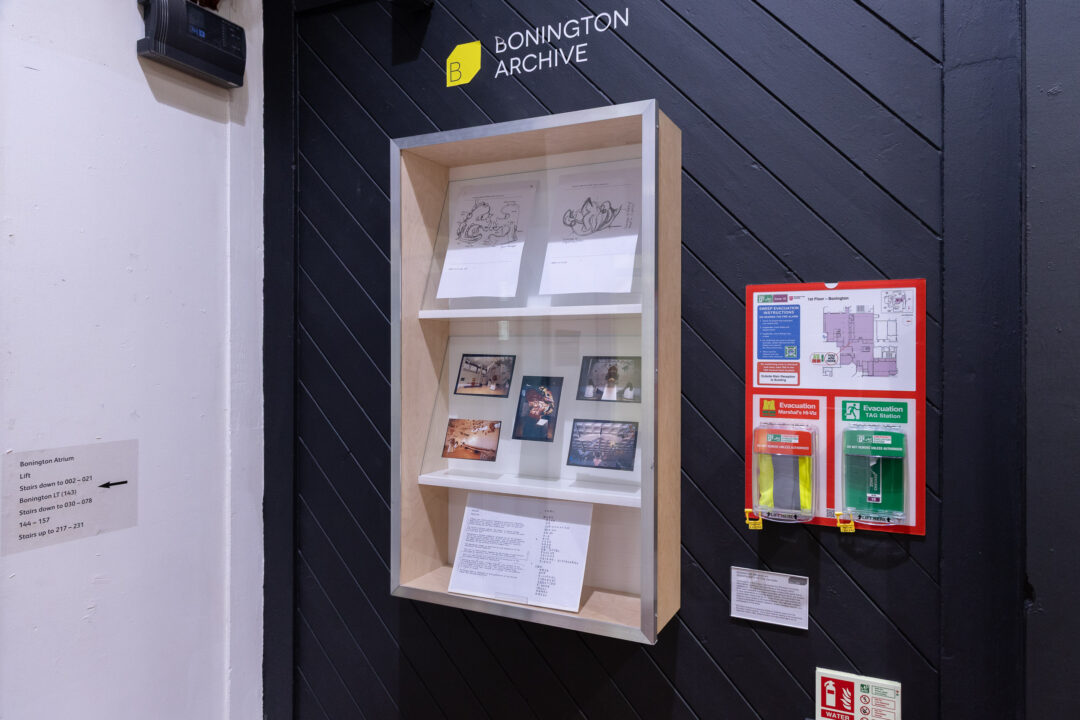
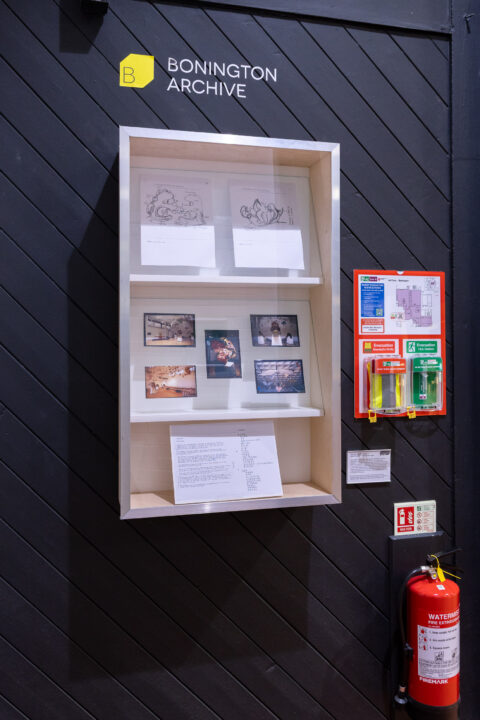
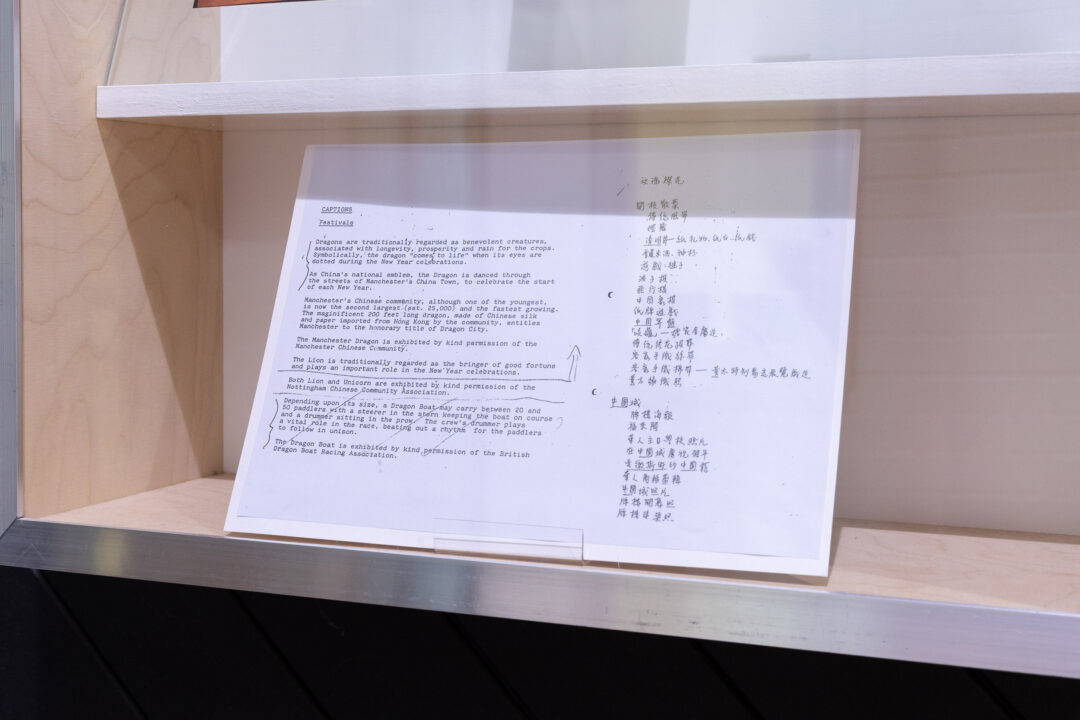
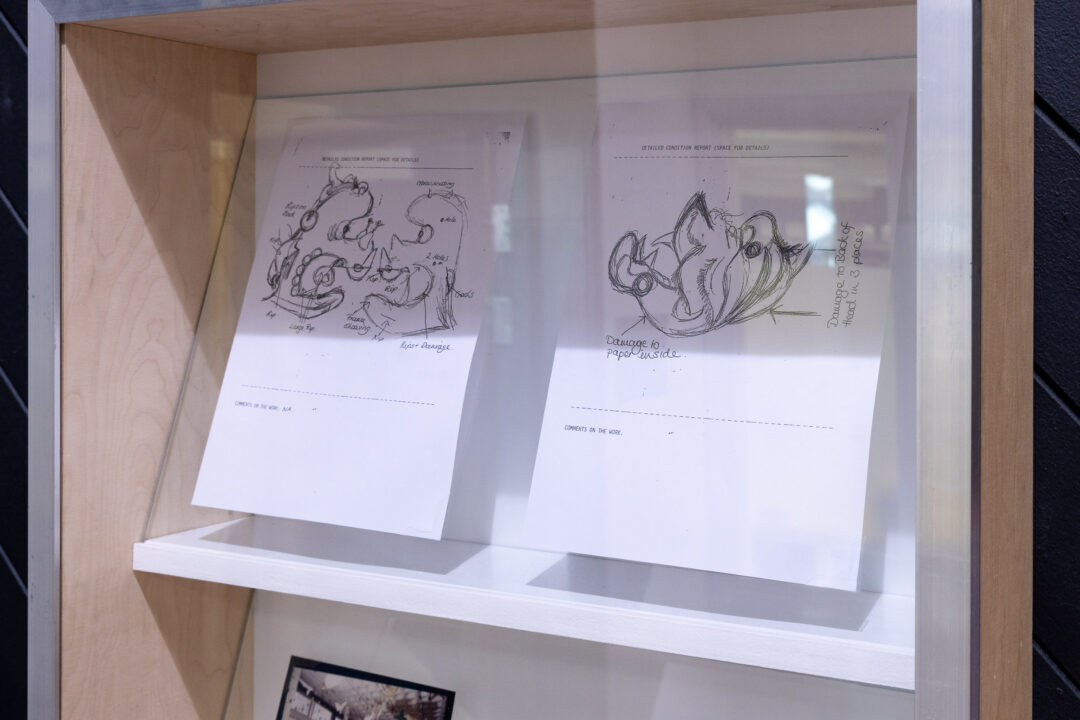
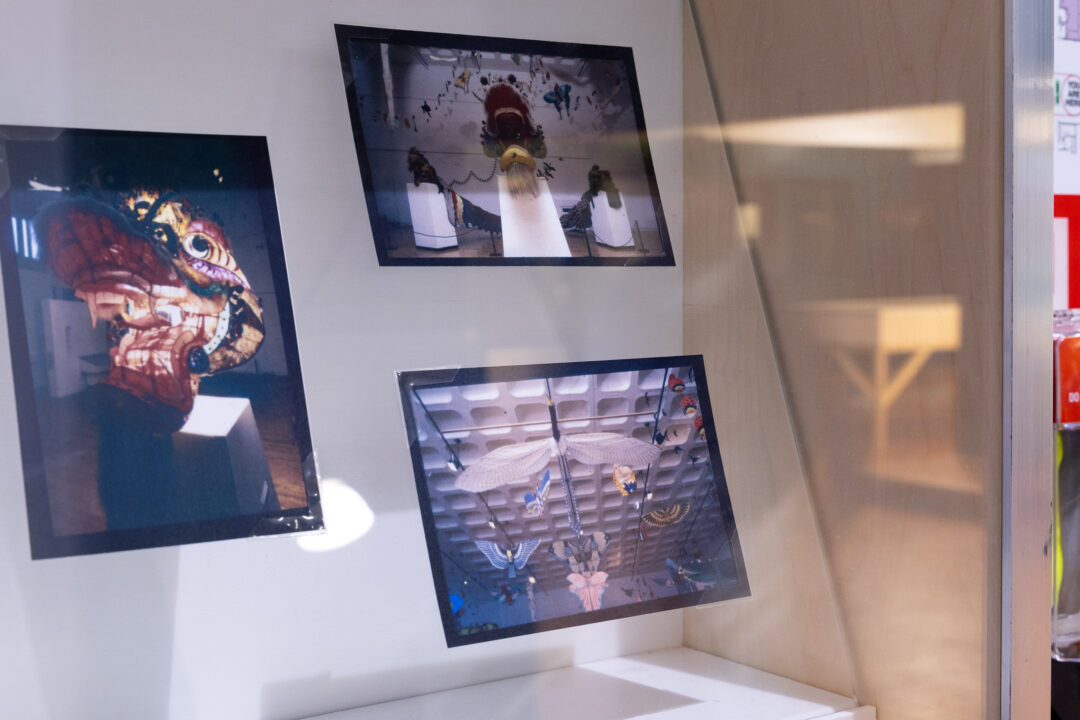
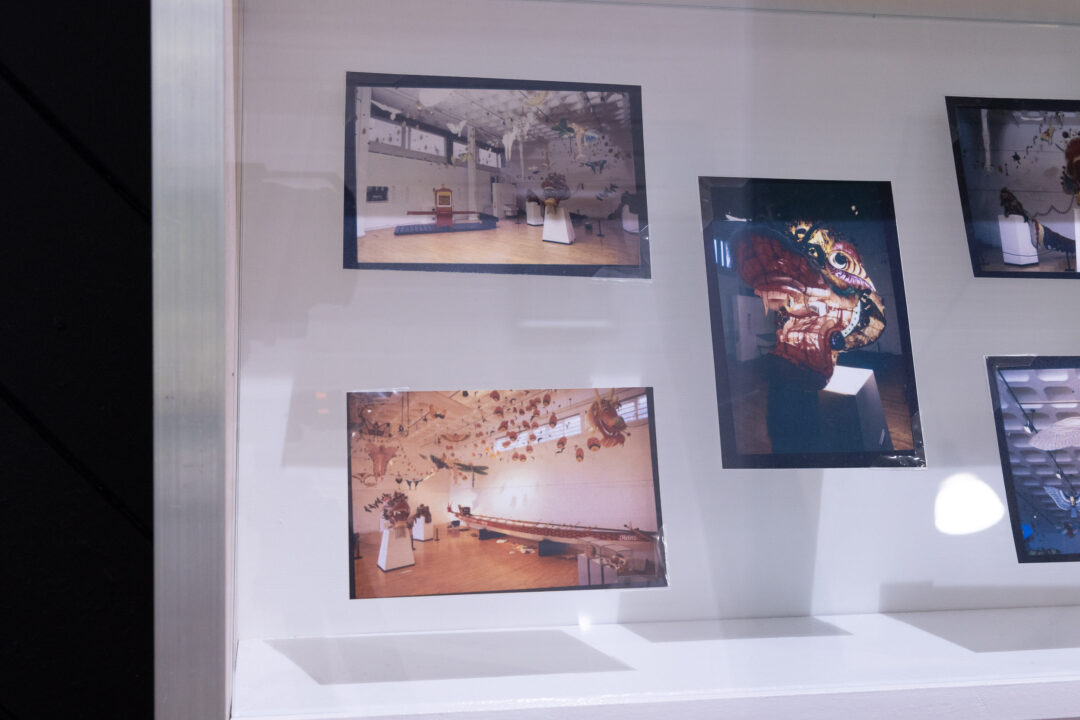
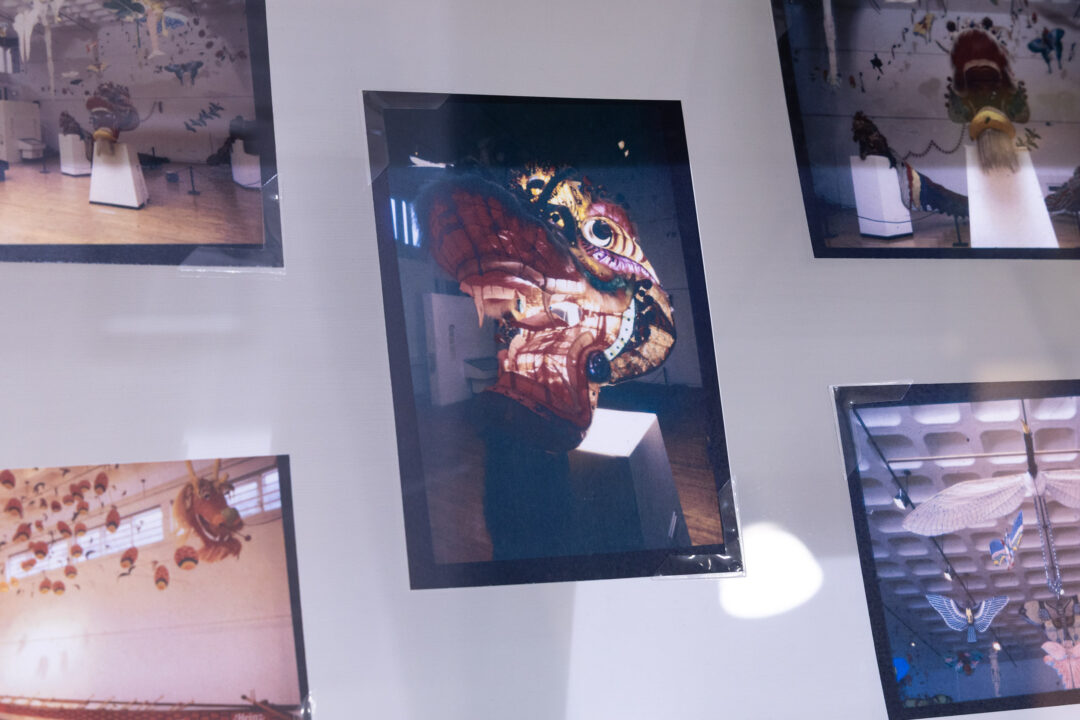
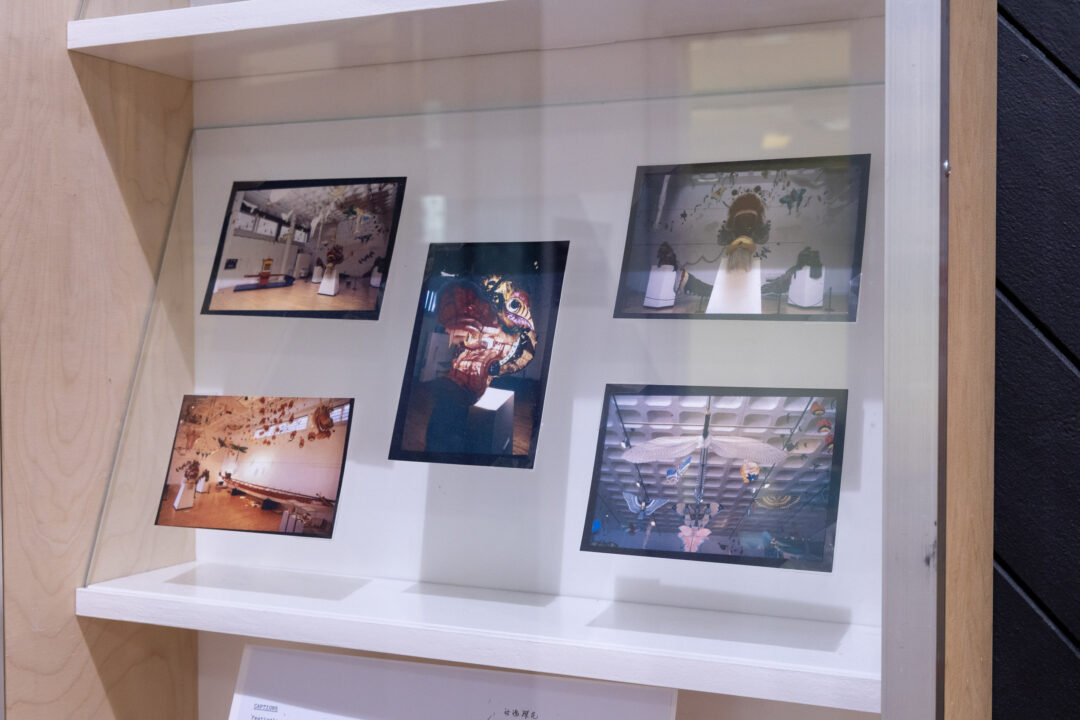
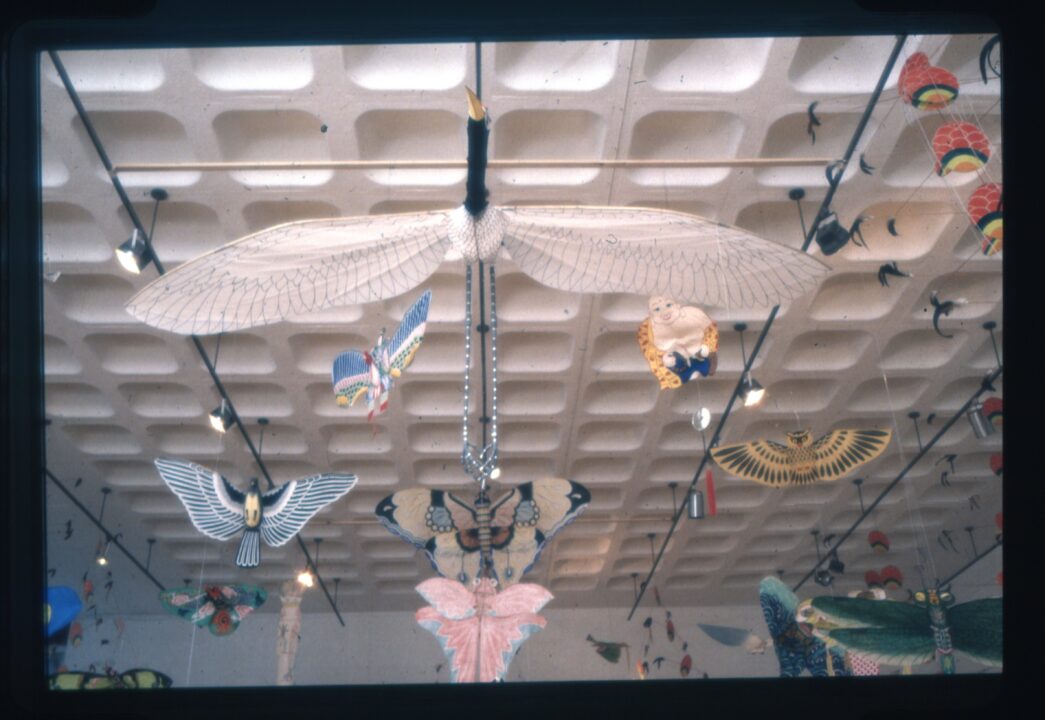
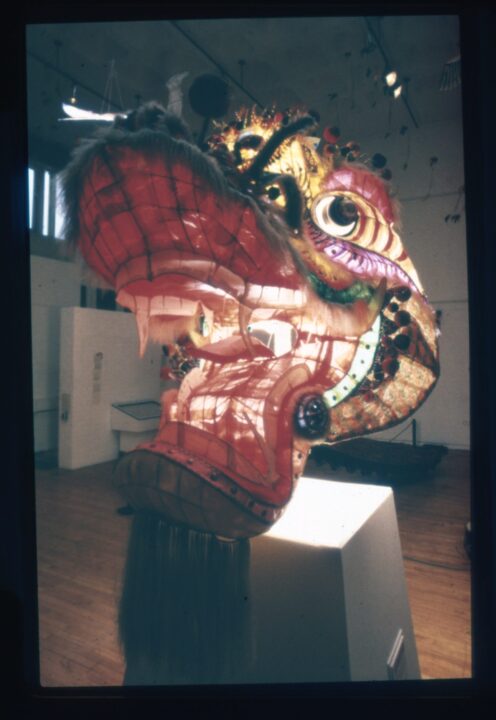
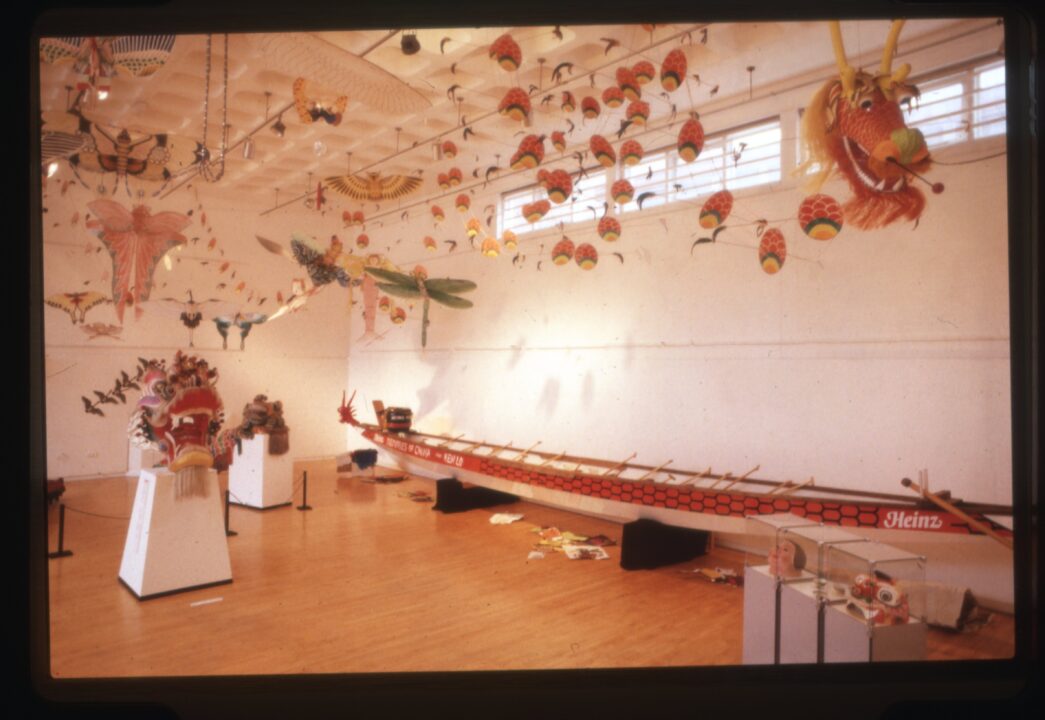
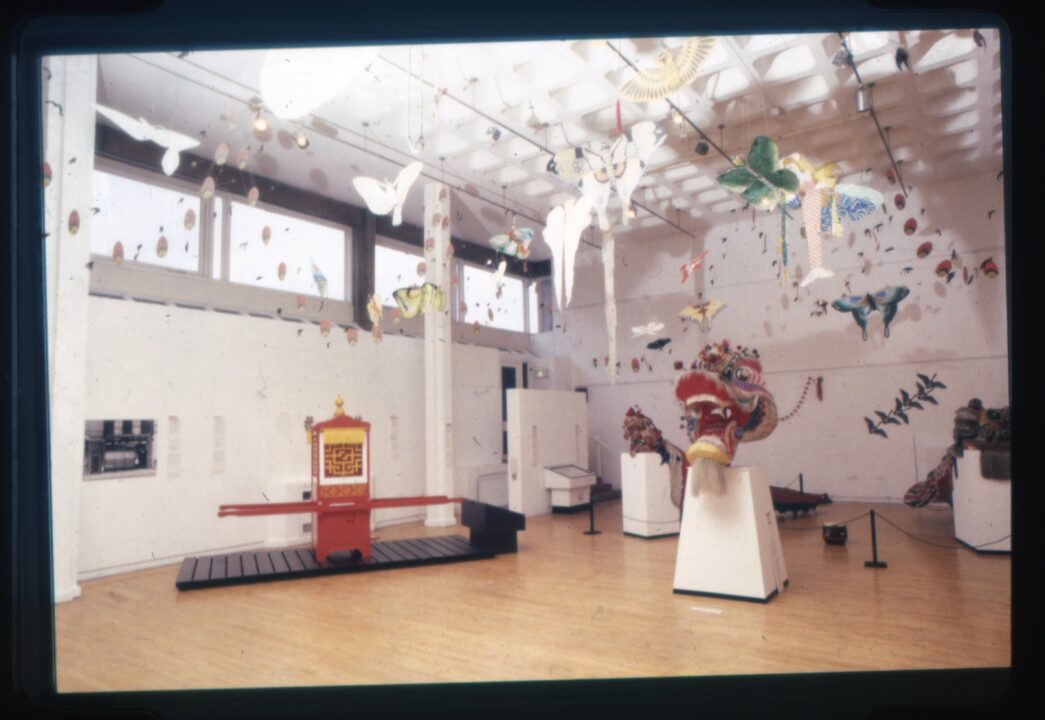
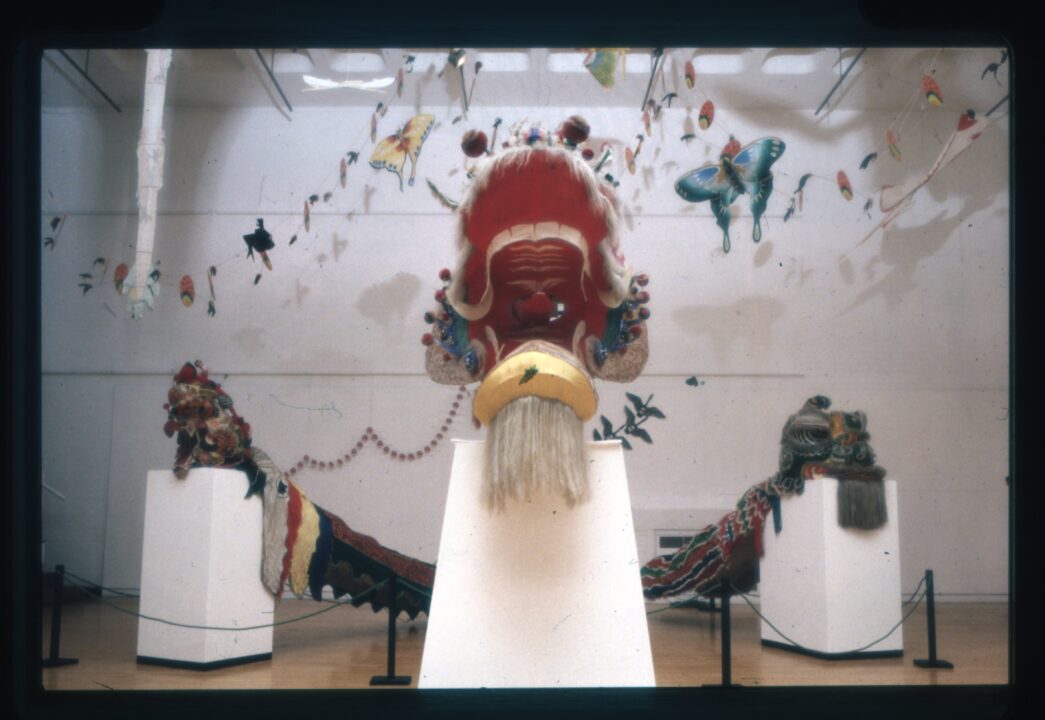

For an exhibition in March 2025, we are running an open call for materials that relate to Nottingham’s independent fashion scene in the 1980’s.
This period was an exciting time for homegrown fashion and style culture. Brands such as G Force, Olto, Cocky’s Shed plus others combined local talent & style discernment, with entrepreneurism & DIY attitudes to start labels, open shops and form connections and influence on a global level.

Do you have any Nottingham labels in your wardrobe? Did you start/run/work for a local label? Did you shop at G Force? Do you have photos of you and your friends wearing garb to The Garage? Did you pick up copies of Nottingham’s style pages Débris or Despatch? etc etc! If so, we’d love to hear your anecdotes, see your photos and materials (Eg. photos of night out, flyers, receipts, magazines, brochures) that relate to the scene and time.

The intention is to build a collection of material that will become part of the exhibition, and if contributors are happy, have this preserved within a growing archive of material going forwards.
In the first instance please email boningtongallery@ntu.ac.uk with any information and digital copies of materials (just snaps on your phone is fine) and we can take the conversation from there.
Representing Lives was a conference that took place in July 1997. The theme explored the multiplicity of women’s identities through the medium of writing biographies and autobiographies, and was funded by the English and Media Studies department at Nottingham Trent University (NTU).
Alongside the conference was an exhibition at Bonington Gallery titled Representing Lives, curated by Pauline Lucas. The exhibition showed four artists, who responded to an open-call which mirrored the themes of the conference, and showcased a mixture of sculpture, painting, photography, and fashion works. The motivation was to examine different perceptions of women in fact and fiction to create a female space within the gallery. To explore this idea, the exhibition featured Hilary Cartmel, Lubaina Himid, Sonia Lawson, and Denise Weston – a mixture of established artists and NTU graduates. Denise Weston studied alongside Donald Rodney, who is the focus of our Bonington Vitrines #25 exhibition.
In addition to the exhibition, Representing Lives was one of the first exhibitions to be documented on Bonington Gallery’s new website. The show lasted for a month in the physical space, but its legacy remained for much longer due to its online presence. In the words of exhibition organiser, Stella Couloutbanis, it was a show “enjoyed by visitors, and computer buffs!”.
On display in the Bonington Archive Cabinet (which can be found in the foyer space outside our main gallery) is the original exhibition proposal by Pauline Lucas, a call for papers for the conference, a memorandum from Stella Couloutbanis to Nick Freestone, a postcard from Pauline Lucas, and images from the original exhibition.
Curated by Alex Jovčić-Sas












Hilary Cartmel graduated from Nottingham Trent Polytechnic in 1980 with a degree in Sculpture. Hilary’s juggler series created out of her customary medium of steel, represents the chaos of modern life. ‘The Clumsy Juggler’ is an androgynous figure which suggests the turmoil of coping with the demands of children, running a busy household whilst pursuing a career.
Hilary has produced sculpture for exhibitions and has shown her work in galleries all over the UK. She has exhibited many pieces of public sculpture on the street, including Carmen which resides outside Nottingham’s Theatre Royal. Hilary has recently completed the gates to the Nottingham Fashion Centre on Convent Street and has produced 27 screens for Rotherham’s Transport Interchange as part of the Interchange’s upgrading.
Denise Weston graduated with an honours degree in Fine Art. She then took an MA in Fine Art at the former Birmingham Polytechnic. Denise currently teaches at Basford Hall College in Nottingham and is a visiting lecturer at NTU. She has exhibited across the country since graduating and is proactive in nurturing artistic talent in Nottingham, notably, by helping to co-ordinate the ‘Oldknows Gallery Exhibitions’ from 1988 – 1993.
Using images of clothing, Denise illustrates her own personal experiences of being a woman whilst escaping the direction of the female form. Flaneuse is a multimedia work which incorporates an image of Denise’s own jacket.
Denise said: “The word ‘Flaneuse’ is the female equivalent of the french word ‘Flaneur’ meaning the spectator and depictor of modern life. The work was inspired by a walk home from the studio late one evening and the realisation that there are still avenues – quite literally – which women feel they cannot explore.”
She elaborated: “I am concerned with using the process of painting as a metaphor; taking the blank canvas and ‘injecting life’ in a similar way that one gives life to inanimate objects, such as toys.”
Lubaina Himid, is a prolific artist who has exhibited across the UK and abroad and currently teaches Fine Art at The University of Central Lancashire. Lubaina has chosen three sets of paintings which challenge the common stereotype of ‘the architect’. For each set there are three paintings – the architect, model, and plan. The series challenges preconceptions of the archetypal architect, by depicting a black woman as the architect in each of the paintings, expressing her vision of a particular building.
Sonia Lawson exhibited six emotive paintings which conveyed the themes of injustice, grief and dignity which are integral to the Representing Lives exhibition.
Her Grieving Women painting (1991) depicts two female figures, one white, one black, standing serenely together as if in mutual and mute understanding of perhaps some deep grief or irrevocable loss. A situation holding no age or time gap.
Lawson’s Boadicea and her Daughters (1991) employs rich and sombre colours which convey a sense of serenity and a monumental dignity in the face of pain, persecution and injustice which they were made to suffer. An earlier work, Homage to Emily Bronte/Night Writing (1982) (from a series of five), is a tribute to the author of Wuthering Heights whose spirited intellect and stout resolve created something so bold and outlandish for its time, a novel that shook, shocked and delighted its readers. When Sonia first read it at the age of 11 it made her feel “wildly liberated” – she didn’t realise it was because she was empathising with one of our early feminists. One of the most striking themes prevalent in the exhibition, is the exploration of the bond between parent and child. Sonia’s painting Gallant Child depicts a child reaching up to the mother figure in a gesture of reassurance.
Sonia explained: “This painting is partly autobiographical, but many people will empathise with the notion of the child as the protector or comforter of a parent.”
Pauline Lucas studied Fine Art at the University of Reading in 1960, and later undertook an MA in Arts Criticism at Birkbeck Collage. Lucas began her career teaching art and art history at at a variety of different institutions across Nottingham and the East Midlands, while also maintaining a career as a freelance curator and exhibition maker.
Lucas’ curatorial work covered many aspects of feminist practice, working primarily with women’s groups who were producing works in a number of different mediums. Her shows were hosted across a number of Nottingham galleries, including Nottingham Castle and Angel Row Gallery. Lucas also published works in a series of catalogues which and publications such as Artline Newspaper.
Bonington Archive is a revolving display of material drawn from the Bonington Gallery Archive. If you have any materials relating to the programme, especially before 1989, please email boningtongallery@ntu.ac.uk
As a legacy to our Art Schools of the East Midlands exhibition by John Beck & Matthew Cornford in Sept/Dec 2023, we invited Stella Couloutbanis who was Exhibition Organiser (later Exhibitions, Events and Festival Director) at Bonington Gallery between 1989 and 2007 to jot down memories of her time at Bonington Gallery & NTU.
This piece of writing is also shared on the occasion of our current Bonington Archive display entitled Stella’s Dilemma, that documents some of the process behind the creation of Tom Hackett’s 1991 solo exhibition Burst. This presentation is on show in the foyer of Bonington Gallery from 16 March – 4 May, 2024.
Memories of Bonington Gallery by Stella Couloutbanis
“In April 1989 I joined Trent Polytechnic as an Exhibitions Organiser for the Bonington Gallery, having left my previous role as Touring Exhibitions Officer within the Arts Division of Nottinghamshire County Council (NCC).
It was an interesting time to join the Polytechnic. Local authorities had relinquished responsibility and Trent Polytechnic was moved away from NCC – two years later becoming an independent university, first called Trent University and later changed to its current name, Nottingham Trent University. With its new statute a Vice Chancellor (VC) was appointed, Professor Ray Cowell. He had a passion for the arts and played a pivotal role in developing the art culture within the university.

The strategy was to transform the space into a public contemporary art gallery. The early years presented some significant challenges, with no designated office area, no staff, a limited budget, limited technical support, no funds to publicise the space, no doors to the gallery, no easy access, and no invigilation.
I initially shared an office within proximity to Professor Robert Ayres, Head of Visual Arts and Fine Art Department, who was my manager and led the vision for the space and the city.
Up to this point the gallery was referred to as ‘The Exhibition Hall’. It had an outline exhibition programme established by external bookings and by members of the Fine Art staff.
To reposition the gallery as a contemporary public gallery we needed to shift away from external bookings and use by internal staff towards a more public remit. Like any change it was initially tricky to implement, but after two years the switch was well underway. The gallery had been renamed to ‘The Bonington Gallery’ (later shortened to just ‘Bonington Gallery’), and a programme of contemporary artworks and performances was being programmed for up to two years ahead.

In the early 1990’s we successfully secured two significant grants which helped elevate the Gallery and establish its position as a public art gallery. We became clients from East Midlands Arts (now the Arts Council England) receiving an annual grant plus match funding from Trent Polytechnic.
The Henry Moore Foundation awarded us a grant to upgrade the gallery, allowing us to procure and fit doors, install a disabled access lift, install bannisters on the staircase, procure and install theatre lights and completely renovate the wooden floor.
We also managed to get a disabled toilet installed in the Bonington building with a grant from Nottinghamshire County Council.
The most amazing thing for me about the Bonington Gallery was its size. It was one of the largest, single room galleries in the Midlands with a ceiling height of 22 feet and 2153 square feet of flooring. It had a beautiful maple floor which was in stark contrast with its brutal concrete egg box ceiling – all these distinguishing features making the gallery iconic, in my opinion. I would often describe the space to artists as a space you walked down into and, “imagine you are at the bottom of an empty public swimming bath”. The vastness of the space also meant the acoustics were difficult to work with making public speaking sometimes a challenge.

Forming partnerships and collaborations with artists and art organisations was pivotal in the gallery’s development and helped create a robust programme. Over the 18 years the team worked with all the key organisations and festivals in Nottinghamshire, such as Dance 4, Now, Expo, Angel Row Gallery, Nottingham Castle Museum & Art Gallery, Djanogly Art Gallery, Wollaton Hall… and many more. Hosting some of the best talent in the arts.
I worked with some amazing artists and performers during my time, too many to count, who were based locally, regionally, nationally and internationally – I never did a head-count, but it must be over a thousand. One of our key success factors was our growing reputation for supporting artists where we would do all that was possible for them to produce their creative work. Mentoring was very important to me, to help artists develop their artistic ideas. We were always being flexible, understanding that work was fluid and the creative outcome could be very different to what was originally proposed.

Bonington Gallery was always a space for site specific and installation work. In 1991 John Newling installed his work, Lost. It covered the entire floor of the gallery with a map of Nottingham City Centre made from paracetamol laid on steel plates. It was a significant point for me – not only was the work powerful and thought provoking with a striking visual impact, it showed that the gallery was ideally positioned to commission site specific works for the space and not just hosting and housing wall and floor-based work.
Over the years we had some fantastic installations; David Wilkinson & Mary McIntyre, Ray Lee, Dunn & Dempster, Shelley Sacks, Ansuman Biswas (collaboration with NOW Ninety 9), Rosie Leverton, Tom Hackett, Lorna Green, Natasha Kidd, Lone Twins, Gobb Squad, Opera North, Bodies in Flight, Hancock and Kelly, Ivan Smith, Susie MacMurray, Mariele Neudecker, Richard Brown are just a few to name.

Dance was a significant aspect of our programme, and we held the first Dance Festival in 1991, organised by Nottinghamshire County Council. At this festival I was introduced to the company Salamanda Tandem. This was the beginning of a very long working relationship between us, lasting several decades. Isabel Jones, the director (a dancer, singer, musician and visual artist) worked in Bonington Gallery for many years and I became chair to the company in 2005.

The gallery was a host and collaborator for Notts Dance and Body Shape Image – two major dance festivals organised by Dance 4. We worked with Expo and Now (Nottingham City Council) presenting, co-commissioning and supporting performances.

Around this time the VC’s passion for the arts led to the establishment of a collection of artworks for the university, focusing on purchasing works from practitioners living and working in the East Midlands. Bonington Gallery was responsible for sourcing, hanging, caring and cataloguing the works.
With an increase in our Arts Council grant, Future Factory was created by Professor Rober Ayers who was appointed as the first Artistic Director ever established at a university. This funding allowed us to commission new work and host our own performance festivals, Celebration Nottingham, Sensitive Skin and Body Space Image. We also ran artist fellowships – giving support, mentoring, opportunities and bursaries to help further their practice. Future Factory’s exhibition and performance programme was housed at Bonington Gallery and Powerhouse, Victoria studios (the site for the new DaDA building). This included a multi-disciplinary contemporary exhibition programme involving photography, film, video, sound and multi-media plus a live art and performance season every year.
When Future Factory was established, Bonington Gallery had a team of eight, including a marketing officer, marketing assistant, technician, education officers, the director and myself. This was an amazing time as it was the start of a feasibility study for a new contemporary art and performance space in Nottingham which was awarded to Nottingham Trent University. The outcome was a success, which led to a further award from Arts Council England to continue with a more thorough and detailed feasibility study working in collaboration with Nottingham City Council and University of Nottingham.

In 2003, due to staff changes, I was promoted to Exhibitions, Events and Festival Director to programme and curate exhibitions, performances and events in Bonington Gallery and 1851 Galleries (Waverley Building), Powerhouse/Basement performance spaces and other University venues. In 2004 I was seconded part time to Nottingham Contemporary as a member of the development team, attending project and client team meetings, stakeholder/sub board meetings and Capital Network meetings.
I have so many happy memories at Bonington Gallery… In the 1990s it was one of the locations for the TV series Boon. We had students exhibiting work in the gallery, including Sue Webster and Tim Noble and we negotiated a fee of £50 per student and a fee for the gallery. In addition, we were allowed to use the catering wagon which was stationed outside the gallery. It took a week for the crew and actors to film a 1-minute-long scene which was a confrontation of a student and a lecturer with a slap on the face!



Having Tom Hackett’s Burst sculpture installation at the Gallery included sourcing, transporting and installing 70 industrial scale cable reels. I cannot remember how we got them in but I do remember the very long chats with the health and safety staff. The Gallery, over the years, has housed many other installations made from a wide variety of materials including bricks, books, fabrics, banana skins, radiators, and performances featuring bodily fluids, duration, audience participation and dancers performing with paintings and other media.


On one occasion an external booking for a flower show had been taken that I was not aware of which clashed with a show I booked in – we had to temporarily take the show down for the weekend to allow the flower show and then rehang it again (not to be recommended!).
We held a Guinness World Record Breaking event. Matt Hand in collaboration with Leif Alexis and Ben Mawson-Harris broke the world record for the longest table tennis rally on their 16th attempt over a 24-hour period, reaching 5 hours, 8 minutes and 22 seconds.

I worked with many students and graduates showing their work in the numerous associated spaces; from gourmet meals being cooked and served by two creative arts students in the Bonington Foyer, to tomato throwing in the gallery, to exhibitions, to awards (Margaret Bryan and Geoff Ball awards) and Expo which was started by NTU graduates.
In 18 years at Bonington Gallery we played host to many school and student placements and graduates. I enjoyed working with all of them, some as volunteers for specific events, others just working at the gallery as assistants supporting our staff and the programme.
I tried to give them an overall experience of what we did at the gallery, from curation, marketing, and education to the hang and finally the opening night. I am very grateful to all our volunteers without whose help it would have made our work much harder. There are so many of them I can’t remember all of them but you know who you are – a big thank you! I have been privileged to work with some amazing volunteers, many of whom have developed their own careers and I hope we played a part in it.
I feel strongly that the work we did at Bonington Gallery/Future Factory was the catalyst for what is now Nottingham Contemporary. Our input in getting the two feasibility study funds from ACE was initiated by us and NTU. Without the initial steer and the passion from Bonington Gallery and Future Factory, Nottingham Contemporary may never have happened.

It was extremely sad for me and my staff to close the doors of Bonington Gallery in August 2007, our Arts Council Grant England Funding had finally been diverted to Nottingham Contemporary which was well on its way in the build and had a new Director in place.
We left with our heads held high, knowing we had done our jobs well. I worked with some amazing people who contributed massively towards Nottingham Contemporary. Deborah Dean, friend and colleague showed outstanding passion and work. Professor Robert Ayres, friend and colleague demonstrated extraordinary vision and determination. NTU VC Professor Ray Cowell, for being such an advocate of the arts in all its forms.
And of course, my amazing team over the 18 years included Janice Britton, John Hewitt, Raif Killips, Stephen Fossey, Jenny Rainforth, Lisa Simmons, Haj Kaur, Sam Rose, Annette Foster, Geoff Litherland, Bo Olawoye… I hope I have not missed any names out!
Looking back, it is great to see Bonington has been repositioned back into the University and continues supporting research and development – something that we were also keen to support during my time at Bonington.
(It is to be noted this has been done by memory as I had no papers to refer to, apologies if I missed any names or organisations out, it was over 15 years ago!)”
For the fifth iteration of our ‘Bonington Archive’ series, we are delighted to present materials from our archive related to Burst, a solo exhibition by artist Tom Hackett that took place in the gallery from 8 May – 9 June 1990. The installation consisted of a large sculpture made from fabric and 80 x 3-8ft wooden cable reels.
These wooden cable reels were sourced by Exhibition Organiser, Stella Couloutbanis, from a British Telecom depot in Arnold, Nottingham. BT agreed to lend these reels for the show, but they would not deliver them to the gallery. So the question was – how do you transport 80 giant cable reels into Bonington Gallery?
The answer? A photoshoot and a press release, obviously!
Curated by Alex Jovčić-Sas







Bonington Archive is a revolving display of material drawn from the Bonington Gallery Archive. If you have any materials relating to the programme, especially before 1989, please contact: joshua.lockwood-moran@ntu.ac.uk
As part of our current Vitrines exhibition, Art [School] Histories, we have been collecting materials from former Nottingham School of Art and Design students and staff that reflect the more candid and informal moments during their time here. Below are a selection of these submissions – see the full set on the specially constructed noticeboard next to the Vitrines, just outside the gallery entrance.
























With thanks to Claire Simpson, Daisy Hayward, Diana Pasek-Atkinson, Lis Evans, Rebecca Efstatiou, Alex Jovcic-Sas, and Giorgio Sadotti. If you have any images or memories you’d like to submit, please email boningtongallery@ntu.ac.uk
The School For Lovers was an exhibition by Sharon Kivland, which took place in November 1998.
The title of the new photographic installations by Sharon Kivland is taken from Mozart’s opera, Cosi fan Tutte. The work is based around the structure of the opera; its arrangement echoes its staging and characterisation. The opera is a work of masquerades and doublings, of couplings which are uncoupled under direction of a libertine, Don Alfonso, sets out to prove to his young friends, Gugliemo and Ferando, that all women are unfaithful and, more than that, anyone can come to fill the place of the Other if the conditions are right; in effect, that desire is essentially the desire of the Other’s desire. Through her work she creates a space of highly formulised attention, an event within which the viewer is drawn like a detective, both intellectually and through desire into pleasure of the gaze.
The archive cabinet contains a recreation of the exhibition plan, images of Kivland’s previous shows, images used in the show, and some of Kivland’s publications. There are also postcards from the artist, to the then Gallery Manager, Stella Cauloutbanis.
Curated by Alex Jovčić-Sas







An exhibiton of women’s artwork being produced now, and influenced by Feminism in the 1980’s. Exhibiton selected by Sutapa Biswas, Sarah Edge and Claire Slattery. This show toured from Cooper Gallery, Barnsley. Part of Anne Frank in the World Programme.
Curated by Joshua Lockwood-Moran

Coinciding with The Art Schools of the East Midlands exhibition, join us for a free event that explores the role of British art schools in shaping fashion, music and club culture over the last 40-50 years.
We will be joined by esteemed writer and curator Paul Gorman, who will discuss his work’s engagement with the significant role played by art schools, their educators and attendees in the broader culture.
Join us as we explore this past and consider it against the wider influence of the notion of the ‘art school’ on other forms of cultural and creative production.
Paul Gorman is a writer, curator and commentator on visual culture. His Books include The Look: Adventures in Rock & Pop Fashion, Mr Freedom – Tommy Roberts: British Design Hero, The Life & Times of Malcolm McLaren and The Wild World of Barney Bubbles. The paperback of his latest book, Totally Wired: The Rise & Fall of the Music Press was published in summer 2023.
Gorman has written for many of the world’s leading publications and curated exhibitions in the UK, continental Europe and the US.
Photo of Paul Gorman by Toby Amies.